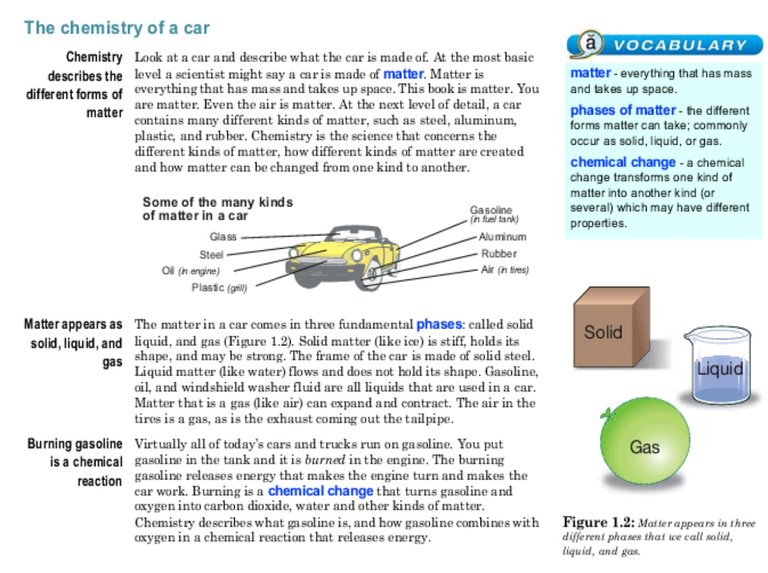Chemistry of a car
Chemistry describes various forms of the subject
The material is displayed as solid, liquid, and gas
A chemical reaction to burning gasoline
Chapter 1: Studying Physics and Chemistry
Look at a car and describe what the car is made of. At the most basic level a scientist can say that a car makes a difference. The objects are mass and take place. This book matters You matter Even air matter In the details of the next level, there are various types of issues in a car such as steel, aluminum, plastic and rubber. Chemistry is a science that concerns the various types of things, how different types of objects are created and how they can change in some other form.
Gasoline (fuel tank)
Aluminum rubber air (in tires)
There are a lot of things in a car
Glass steel oil (engine) plastic (grill)
The case of a car comes at three basic levels: called solid liquids and gas (Figure 1.2). Solid objects (like ice) are strong, can hold their shape and become strong. Car frame is made of solid steel. Do not stream the fluid (like water) and keep its shape. Gasoline, oil, and windshield washer liquid are all liquids that are used in a car. A gas (like air) that can extend and contract matter. Tire air is a gas, such as drainage lejection.
Virtually all of today's cars and trucks run petrol. You keep the gasoline in the tank and it is burned in the engine. The flaming gasoline turns the engine and exposes the energy that the car works on. Burning is a chemical change that makes petrol and oxygen in carbon dioxide, water and other substances. What chemistry describes gasoline and how gasoline emits oxygen in chemical reaction.
Thing - everything that has the mass and takes place.
The stage of matter - can take different forms; Usually occur as hard, liquid, or gas.
Chemical changes - A chemical change converts one type of object into another type (or different) field.
Difficult
Liquid
Gas
Fig. 1.2: The material is displayed in three stages, which we call hard, liquid and gas.
5
1.1 Physical science of your life 
Sort: Trending